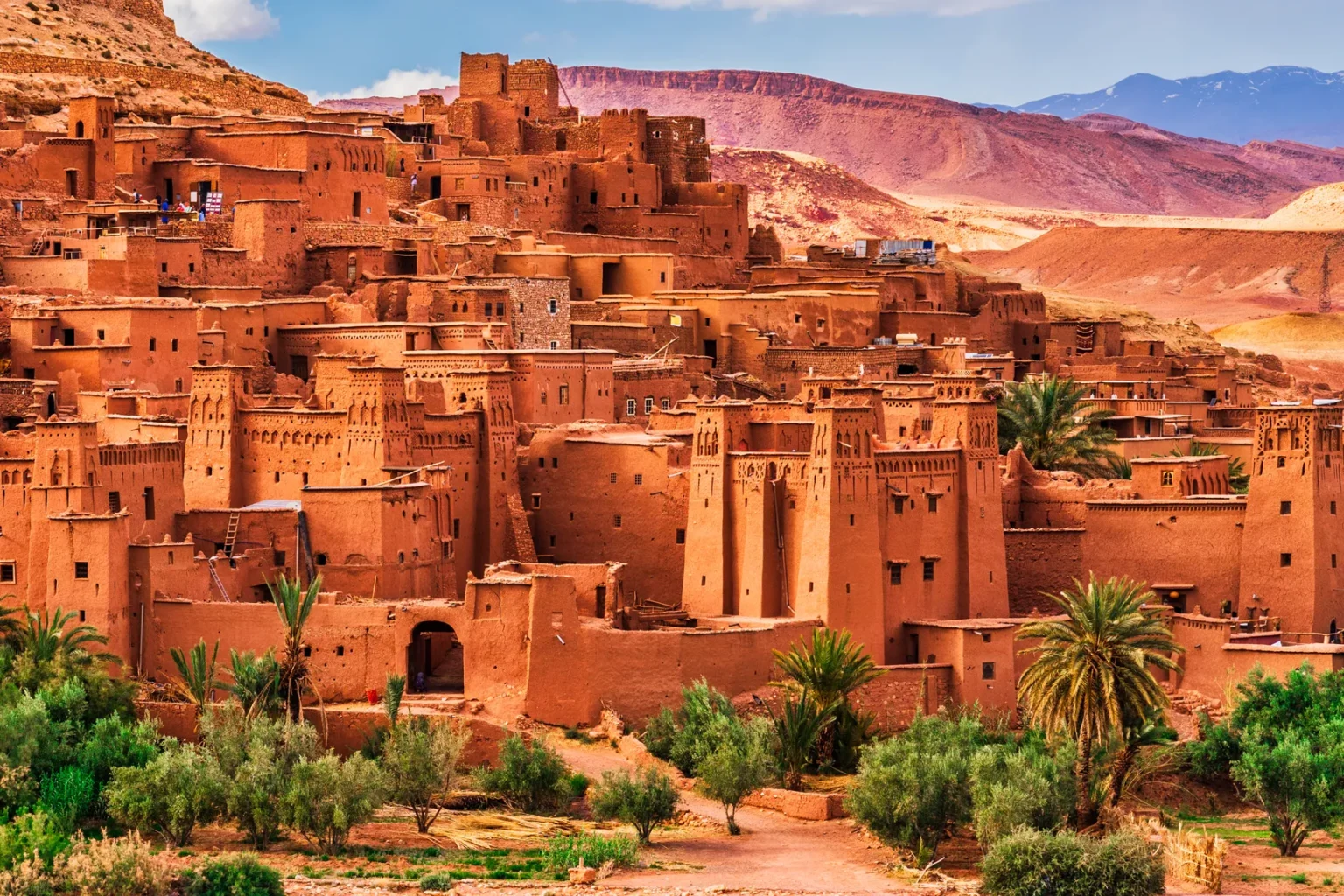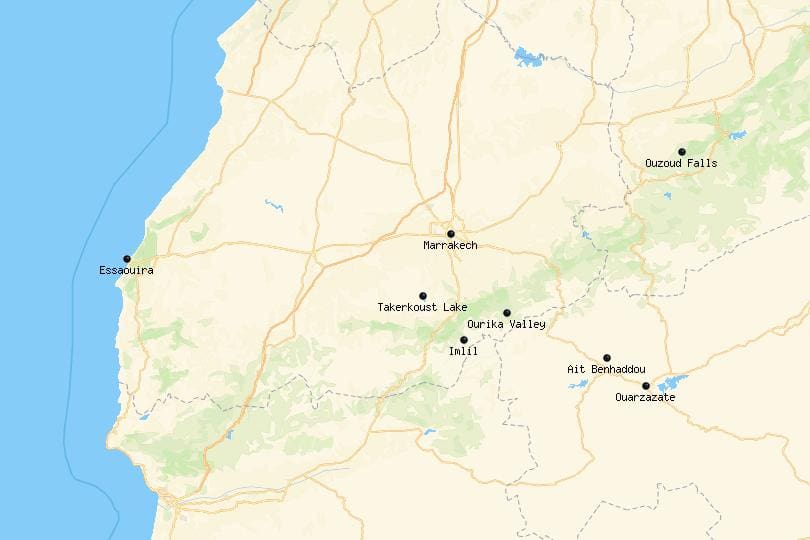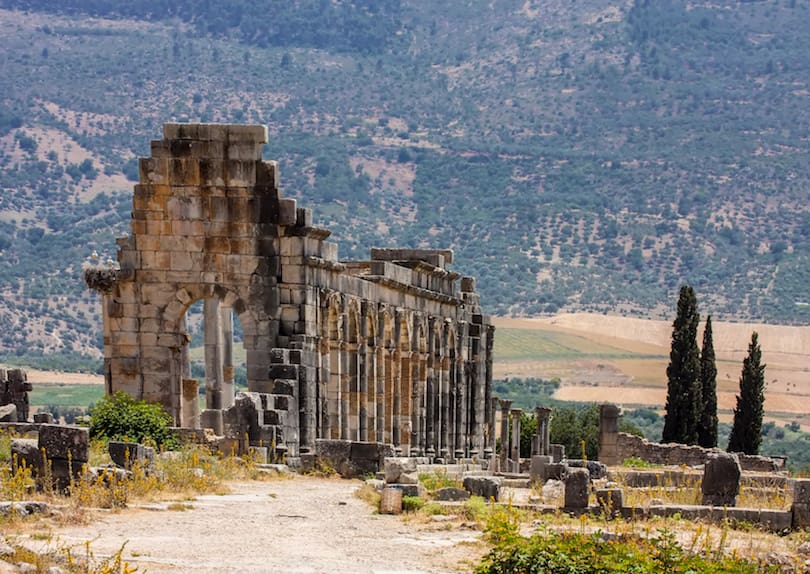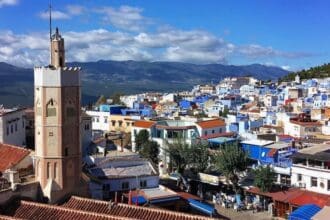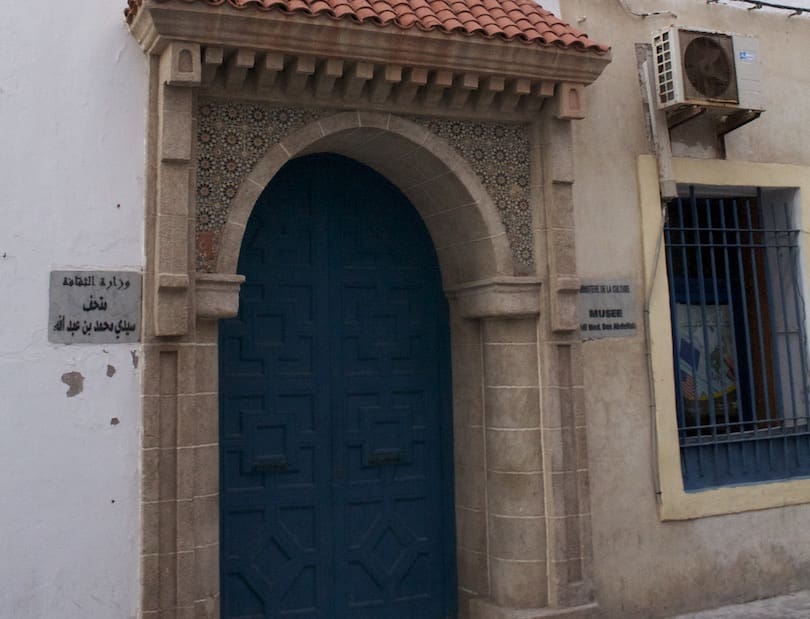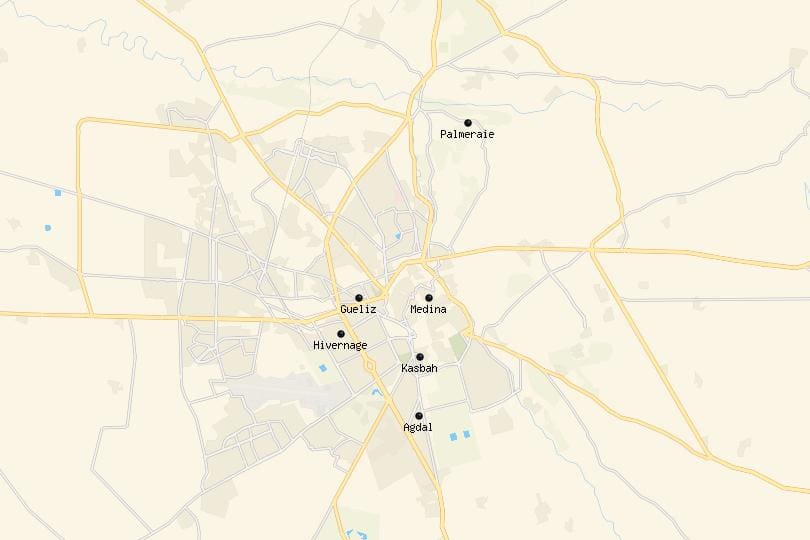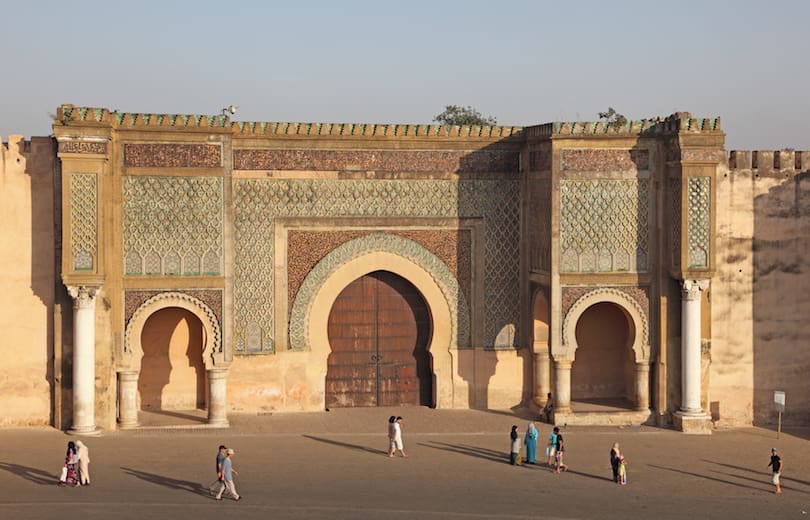Morocco is a country of dazzling contrasts—rich cultural heritage, vibrant landscapes, bustling medinas, serene deserts, and beautiful coastal cities. Whether you’re a history enthusiast, adventure seeker, or someone looking to unwind, Morocco offers something unique for every type of traveler. From ancient cities that date back centuries to the bustling marketplaces that reveal the heart of the nation, Morocco is a land that offers endless exploration.
This guide will walk you through the best cities to visit in Morocco, each showcasing its unique character and heritage. Get ready to immerse yourself in Morocco’s diverse beauty, rich culture, and deep traditions.
1. Marrakech – The Enchanting Red City
Marrakech is a city like no other, a place where ancient traditions meet modern sophistication. Known for its vibrant souks, colorful architecture, and iconic landmarks, Marrakech is a city that can be explored endlessly. Whether you’re wandering through the medina or relaxing in a traditional riad, Marrakech offers a sensory overload that will capture your heart.
Top Attractions:
- Jemaa el-Fnaa Square: This bustling square is the beating heart of Marrakech, where street performers, food stalls, and snake charmers fill the air with excitement. As night falls, the square transforms into a magical hub, with live music, performers, and delicious Moroccan street food.
- Bahia Palace: A stunning example of Moroccan architecture, this palace features lush gardens, intricate tile work, and beautiful courtyards that will transport you back in time.
- Koutoubia Mosque: With its towering minaret that stands at 77 meters, the Koutoubia Mosque is the tallest structure in Marrakech and an iconic landmark of the city. It’s a fantastic example of traditional Moroccan architecture.
- Majorelle Garden: Created by French painter Jacques Majorelle, this garden is famous for its brilliant blue colors, exotic plants, and peaceful atmosphere. It’s also home to the Yves Saint Laurent Museum, which adds to its charm.
Marrakech is a city full of life, history, and culture, making it a must-visit for anyone traveling to Morocco.
2. Fes – The Spiritual and Intellectual Heart of Morocco
Fes is often regarded as Morocco’s spiritual and intellectual capital, boasting one of the oldest and most well-preserved medieval cities in the world. It’s a place where you can truly feel the weight of history and immerse yourself in the country’s ancient traditions.
Top Attractions:
- Fes el-Bali (Old Medina): A UNESCO World Heritage site, Fes el-Bali is an expansive, labyrinthine medina filled with narrow alleyways, bustling souks, and ancient buildings. The medina is a living museum, and getting lost in its alleys is part of the experience.
- Al-Qarawiyyin University: Founded in 859, it is the oldest continuously operating degree-granting university in the world. It’s a significant cultural and educational institution that has had a profound influence on the intellectual history of the Islamic world.
- Bou Inania Madrasa: This stunning 14th-century religious school is an excellent example of Islamic architecture, with intricate carvings, tile work, and a peaceful courtyard.
- Chouara Tannery: One of the most iconic sights in Fes, the Chouara Tannery is where leather has been tanned in the same traditional methods for centuries. Visitors can view the process from terraces that overlook the tannery.
Fes is perfect for history lovers and anyone interested in diving deep into the cultural and intellectual traditions of Morocco.
3. Casablanca – A Blend of Modernity and Tradition
As Morocco’s largest city and economic hub, Casablanca offers a cosmopolitan experience with a mix of modern infrastructure and traditional Moroccan culture. Known for its vibrant nightlife, beautiful beaches, and stunning architectural landmarks, Casablanca is where you can experience both the old and new Morocco.
Top Attractions:
- Hassan II Mosque: One of the largest mosques in the world, the Hassan II Mosque is a marvel of Islamic architecture. Its minaret is the tallest in the world, and the mosque’s location on the edge of the Atlantic Ocean offers spectacular views.
- Old Medina: While not as old or sprawling as those in Fes or Marrakech, Casablanca’s Old Medina still offers a slice of traditional Moroccan life, with narrow streets, cafes, and markets to explore.
- Corniche: This beachfront promenade is a popular spot for both locals and tourists. With seaside views, restaurants, and cafes, it’s the perfect place to relax and take in the atmosphere of the city.
- Royal Palace: The official residence of the Moroccan King, the Royal Palace is an impressive piece of architecture, though visitors can only admire it from the outside.
Casablanca is the ideal city for travelers who want to experience a modern, thriving city while still embracing traditional Moroccan culture.
4. Chefchaouen – The Blue City of Tranquility
Chefchaouen is often called the “Blue Pearl” of Morocco, and it’s easy to see why. The entire city is painted in varying shades of blue, which gives it a serene and magical atmosphere. Nestled in the Rif Mountains, Chefchaouen offers a peaceful escape and a beautiful setting for photography and relaxation.
Top Attractions:
- The Medina: The town’s medina is filled with narrow, winding streets painted in beautiful shades of blue. The medina is the perfect place to get lost, shop for handicrafts, and take in the tranquility of the town.
- Ras Elma River: The river runs through Chefchaouen and provides a calming environment for visitors. You can walk along the river and enjoy the fresh air, or stop at one of the cafes for a refreshing drink.
- Spanish Mosque: Located on a hill above the city, this mosque offers panoramic views of Chefchaouen and the surrounding mountains.
Chefchaouen is perfect for travelers who want a laid-back experience in a stunningly beautiful setting, making it ideal for relaxation, photography, and exploring local culture.
5. Merzouga – The Gateway to the Sahara Desert
Merzouga is a small village located at the edge of the Sahara Desert and is the starting point for most desert tours. The vast, golden sand dunes of Erg Chebbi are a sight to behold, and spending time in the Sahara is an unforgettable experience.
Top Attractions:
- Erg Chebbi Dunes: These enormous sand dunes are the highlight of Merzouga, where you can take a camel ride to the top and watch the breathtaking sunset over the desert.
- Camel Treks: Guided camel treks through the desert provide a once-in-a-lifetime opportunity to experience the nomadic lifestyle and spend a night in a traditional desert camp.
- Desert Camping: Sleeping under the stars in a Berber tent is an unforgettable experience, as the vast desert landscape creates a peaceful and serene environment.
Merzouga is perfect for adventure seekers and those looking to experience the stunning beauty and solitude of the Sahara Desert.
6. Rabat – Morocco’s Capital of Culture
Rabat is Morocco’s capital, offering a laid-back atmosphere with a perfect blend of modernity and tradition. Situated on the Atlantic coast, Rabat is known for its clean streets, beautiful gardens, and historical landmarks.
Top Attractions:
- Hassan Tower: This partially completed minaret is part of an ancient mosque that was planned to be the largest in the world. The tower is an important symbol of the city.
- Kasbah of the Udayas: A charming fortress with narrow, cobbled streets, white-and-blue buildings, and panoramic views of the Atlantic Ocean.
- Royal Palace: The residence of the Moroccan King, the Royal Palace is an exquisite example of Moroccan architecture and surrounded by lush gardens.
Rabat offers a more peaceful and modern side of Morocco, making it ideal for those looking for a relaxed yet culturally rich experience.
7. Essaouira – A Coastal Retreat
Essaouira is a charming coastal city known for its breezy beaches, whitewashed buildings, and vibrant art scene. A UNESCO World Heritage site, Essaouira combines history, culture, and natural beauty in a way that few cities can.
Top Attractions:
- Medina of Essaouira: The medina is filled with narrow streets, bustling souks, and vibrant markets. The city’s art galleries, workshops, and cafes add to its bohemian charm.
- Essaouira Beach: Known for its wind, Essaouira is a popular destination for windsurfing and kite surfing. The beach is also perfect for relaxing and enjoying the beautiful coastline.
- Skala de la Ville: This historic fortress offers panoramic views of the sea and the city, making it a great spot for taking in the scenery.
Essaouira is the perfect coastal destination for beach lovers, art enthusiasts, and those seeking a slower pace of life.
8. Tangier – The Crossroads of Europe and Africa
Tangier is located on the northern tip of Morocco and serves as a crossroads between Europe and Africa. The city has long been a melting pot of cultures, offering a blend of Arab, European, and African influences.
Top Attractions:
- Medina of Tangier: The city’s medina is a mix of winding alleys, bustling markets, and vibrant cafes. It’s a great place to explore on foot and immerse yourself in the local atmosphere.
- Kasbah Museum: Housed in a former palace, this museum showcases Moroccan history, art, and culture.
- Cave of Hercules: This natural cave offers stunning views of the ocean and is linked to Greek mythology. It’s a popular tourist destination for its historical significance.
Tangier is ideal for travelers looking for a fusion of European and African cultures with stunning coastal views.
Conclusion
From the bustling streets of Marrakech and Fes to the serene beaches of Essaouira and the vast sands of Merzouga, Morocco is a land of contrasts that offers something for every traveler. Each city in Morocco provides a unique glimpse into the rich culture, history, and beauty of this North African gem. Whether you’re looking to explore ancient cities, immerse yourself in nature, or simply unwind by the sea, Morocco is a destination that will leave a lasting impression.
Frequently Asked Questions (FAQs)
- What is the best time to visit Morocco?
- The best time to visit Morocco is during the spring (March to May) and fall (September to November) months. The weather is moderate, and you can explore the cities comfortably. The summer months can be very hot, especially in desert regions, while winter is great for mountain activities.
- Is Morocco safe for tourists?
- Yes, Morocco is generally safe for tourists. However, like traveling to any destination, it’s essential to exercise caution, especially in busy cities or crowded areas. Keep an eye on your belongings, avoid poorly lit areas at night, and respect local customs.
- Do I need a visa to visit Morocco?
- Citizens from many countries, including the US, UK, Canada, and most EU nations, can enter Morocco without a visa for up to 90 days. It’s advisable to check the specific visa requirements based on your nationality before traveling.
- What should I wear when visiting Morocco?
- Morocco has a diverse culture, and it’s essential to dress modestly, especially when visiting religious sites. Women should cover their shoulders and knees, while men should avoid wearing shorts in more traditional areas. Lightweight, comfortable clothes are recommended, especially for desert excursions.
- What is the currency used in Morocco?
- The official currency of Morocco is the Moroccan Dirham (MAD). It is advisable to exchange currency at official exchange offices or banks for the best rates.
- How can I get around Morocco?
- Morocco has various transportation options, including buses, taxis, trains, and domestic flights. Trains are a popular way to travel between major cities, while taxis are ideal for short trips. Renting a car is also a good option if you plan to explore rural areas.
- Is bargaining common in Moroccan markets (souks)?
- Yes, bargaining is a traditional part of shopping in Moroccan souks. It’s expected and is a fun way to engage with local merchants. Start by offering a lower price than what is quoted, and negotiate until you reach an agreeable price.
- What language is spoken in Morocco?
- Arabic and Berber are the official languages of Morocco, but French is widely spoken, especially in major cities and tourist areas. English is commonly understood in tourist spots, but learning a few basic phrases in Arabic or French can be helpful.
- What is the food like in Morocco?
- Moroccan cuisine is flavorful and diverse, with spices playing a central role. Common dishes include tagine (a slow-cooked stew), couscous, pastilla (a savory pie), and mint tea. Street food, such as grilled kebabs and fresh juices, is also popular in cities like Marrakech and Fes.
- Can I visit the Sahara Desert from major cities?
- Yes, you can easily take organized tours from cities like Marrakech, Fes, and Merzouga to the Sahara Desert. Camel treks, desert camps, and visits to the sand dunes of Erg Chebbi are popular desert experiences.
- What are some must-try activities in Morocco?
- Some must-try activities include visiting the medinas of Fes and Marrakech, exploring the Sahara Desert on a camel, hiking in the Atlas Mountains, visiting ancient kasbahs, and experiencing the local cuisine.
- How long should I spend in Morocco?
- A week to 10 days is ideal for exploring Morocco’s highlights. You can visit major cities, the Atlas Mountains, and the Sahara Desert in this time. If you have more time, you can venture into the coastal areas or explore the countryside.
- Are there any customs or etiquette I should be aware of?
- Yes, respect for local customs is important. When visiting mosques or religious sites, dress modestly and remove your shoes. Public displays of affection should be avoided, especially in more conservative areas. Always greet locals with “As-salamu alaykum” (Peace be upon you).

